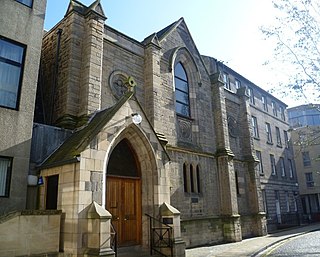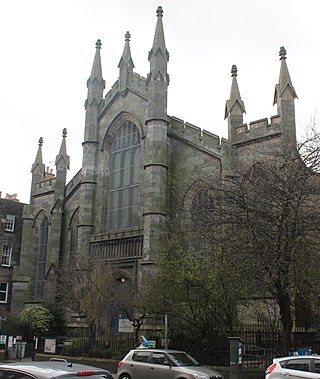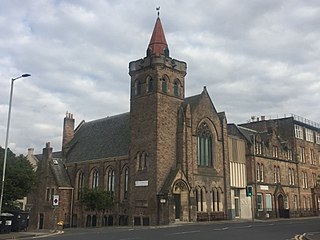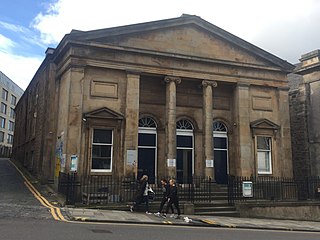
John Jamieson DD was a Scottish minister of religion, lexicographer, philologist and antiquary. His most important work is the Dictionary of the Scottish Language.
The United Secession Church was a Scottish Presbyterian denomination which existed between 1820 and 1847.

The Anti-Burghers were opponents of the Burgher Oath on theological grounds.

James Aitken Wylie was a Scottish historian of religion and Presbyterian minister. He was a prolific writer and is most famous for writing The History of Protestantism.

Thomas M'Crie was a Scottish biographer and ecclesiastical historian, writer, and preacher born in the town of Duns, and educated at the University of Edinburgh. He became the leading minister of the Original Secession Church. His work: "Life of Knox" (1813) was a means of vindicating the Scottish reformer John Knox who was a unpopular figure at the time. It was followed by a "Life of Andrew Melville" (1819). Melville was Knox's successor as the leader of the Reformers in Scotland. M'Crie also published histories of the Reformation in Italy and Spain. He received an honorary degree of D.D. in 1813, the first Secession minister to receive such an award.

Thomas M'Crie was a Presbyterian minister and church historian. He was a Scottish Secession minister who joined the Free Church of Scotland and served as the Moderator of the General Assembly to that church 1856/57.

The First Secession was an exodus of ministers and members from the Church of Scotland in 1733. Those who took part formed the Associate Presbytery and later the United Secession Church. They were often referred to as Seceders.
Archibald Bruce (1746–1816), was a Scottish theological writer.
In the Scottish church of the 18th and 19th centuries, a burgher was a member of that party amongst the seceders which asserted the lawfulness of the burgess oath.

The Original Secession Church or United Original Secession Church was a Scottish Presbyterian denomination formed in 1827 by the union of (1) the Anti-Burgher Old Lights, led by Thomas M'Crie the Elder and known as "the Constitutional Associate Presbytery" and (2) the portion of the Anti-Burgher New Lights that refused to merge with the Burgher New Lights, led by George Paxton and known as "the Synod of Protesters". The title 'United Original Secession Church' was adopted in 1842, after the 'Original Secession Church', by then led by Thomas M'Crie the Younger, united with the portion of the Burgher Old Lights that refused to merge with the Church of Scotland. In 1852 some of its members, including Thomas M'Crie the Younger, merged with the Free Church of Scotland formed by the Disruption of 1843. In 1956 the remainder of the Original Secession Church merged with the Church of Scotland.

George Paxton was a Scottish secession minister and poet. He was the professor of divinity of the 'New Licht' Anti-Burgher General Associate Synod.

The King Khalid Building is an event space in the Southside, Edinburgh, Scotland, owned and operated by the Royal College of Surgeons of Edinburgh. The building was constructed Roxburgh Free Church in 1847 and converted to its current use in 1982.

The Southside Community Centre is a community centre in the Southside, Edinburgh, Scotland, United Kingdom. The centre opened in 1986 and occupies the former Nicolson Street Church, which was completed in 1820.
John Reid was a Presbyterian minister from Scotland who was also active in England and Australia. Born in Ayrshire, he was ordained into the United Secession Church in 1829, but later led independent and Burgher churches. He joined the established Church of Scotland in 1839, and in 1845 took over an expatriate congregation in Liverpool, England. Reid immigrated to Australia in 1852, living in Melbourne until 1858 and then in Sydney. He left the Church of Scotland and for a while ministered in John Dunmore Lang's schismatic sect, eventually ending his career at a non-denominational Bethel Union congregation. His son George Reid became the fourth Prime Minister of Australia.

Bristo Church was a Presbyterian church located in the Bristo area of Edinburgh, Scotland. Founded in 1741 as a Secession church, it reunited with the Church of Scotland in 1929 before being dissolved in 1937. The University of Edinburgh afterwards used the building as the Pollock Memorial Hall until its demolition in 1967.

The King's Hall is a church in Newington, Edinburgh, Scotland. Constructed as Newington Free Church in 1843, it is now used by Community Church Edinburgh: an independent evangelical congregation.

St Paul's Parish Church was a parish church of the Church of Scotland located in St Leonard's, Edinburgh, Scotland. Its building served as a church between 1836 and 1942 before being demolished in 1980.

Pleasance Church was a Presbyterian church on the Pleasance in the Southside of Edinburgh, Scotland. Originating in the Relief Church in the 1820s, the congregation united with Charteris Memorial in 1953.

The Greyfriars Charteris Centre is a community centre in the Southside, Edinburgh, Scotland, part of the mission of Greyfriars Kirk. The centre opened in 2016 and occupies the 20th century church buildings which became Kirk o' Field Parish Church in 1969.

St Oran's Church was a Gaelic-speaking congregation of the Church of Scotland in Edinburgh. Originating in the early 18th-century, the congregation continued until 1948, latterly meeting at Broughton Street.



















